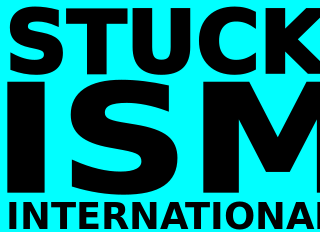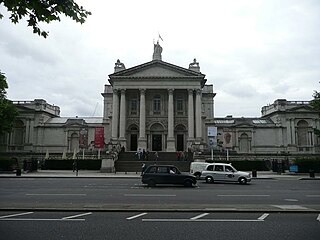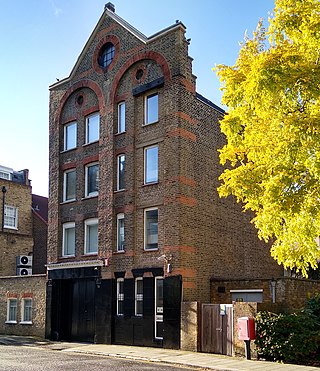Related Research Articles

Stuckism is an international art movement founded in 1999 by Billy Childish and Charles Thomson to promote figurative painting as opposed to conceptual art. By May 2017 the initial group of 13 British artists had expanded to 236 groups in 52 countries.

Tate is an institution that houses, in a network of four art galleries, the United Kingdom's national collection of British art, and international modern and contemporary art. It is not a government institution, but its main sponsor is the UK Department for Culture, Media and Sport.

The Turner Prize, named after the English painter J. M. W. Turner, is an annual prize presented to a British visual artist. Between 1991 and 2016, only artists under the age of 50 were eligible. The prize is awarded at Tate Britain every other year, with various venues outside of London being used in alternate years. Since its beginnings in 1984 it has become the UK's most publicised art award. The award represents all media.
Lucy Skaer is a contemporary English artist who works with sculpture, film, painting, and drawing. Her work has been exhibited internationally. Skaer is a member of the Henry VIII’s Wives artist collective, and has exhibited a number of works with the group.
Anya Gallaccio is a British artist, who creates site-specific, minimalist installations and often works with organic matter.

Tate St Ives is an art gallery in St Ives, Cornwall, England, exhibiting work by modern British artists with links to the St Ives area. The Tate also took over management of another museum in the town, the Barbara Hepworth Museum and Sculpture Garden, in 1980.
Rebecca Jane Warren is a British visual artist and sculptor, born in Pinhoe, Exeter. She is particularly well known for her works in clay and bronze and for her arranged vitrines. The artist currently lives and works in London.
Tomma Abts is a German-born visual artist known for her abstract oil paintings. Abts won the Turner Prize in 2006. She currently lives and works in London, England.
Mark Titchner is an English artist, and 2006 nominee for the Turner Prize. He lives and works in London. Focusing on an exploration of words and language, in recent years much of his production has been based in the public realm both in the UK and internationally. These public works have often been created from extended group activities.

Shirazeh Houshiary is an Iranian-born English sculptor, installation artist, and painter. She lives and works in London.

Sir Nicholas Serota Makes an Acquisitions Decision is one of the paintings that was made as a part of the Stuckism art movement, and is recognized as a "signature piece" for the movement, It was painted by the Stuckism co-founder Charles Thomson in 2000, and has been exhibited in a number of shows since, as well as being featured on placards during Stuckist demonstrations against the Turner Prize.
Runa Islam is a Bangladeshi-born British visual artist and filmmaker based in London. She was a nominee for the 2008 Turner Prize. She is principally known for her film works.
Cathy Wilkes is a Northern Irish artist who lives and works in Glasgow. She makes sculpture, paintings, and installations. She was the recipient of the Inaugural Maria Lassnig Prize in 2017 and was commissioned to create the British Pavilion in Venice in 2019.

The 2008 Turner Prize was awarded on 1 December 2008 to Mark Leckey. The £25,000 Turner Prize is awarded by the Tate to one of four nominees and is based on their work in the previous year. The other three 2008 nominees were Runa Islam, Goshka Macuga and Cathy Wilkes; for the first time since 1998, there were three female nominees. The chairman of the jury was Stephen Deuchar, director of Tate Britain. The artwork shown by the nominees at the invitational exhibition was generally unpopular with critics.
The 2007 Turner Prize for modern British art was awarded on 3 December 2007. It was the 22nd Turner Prize competition. There were four nominees for the 2007 prize and the winner was Mark Wallinger.
The four nominees for the Tate gallery's 2009 Turner Prize were Enrico David, Roger Hiorns, Lucy Skaer and Richard Wright. The award went to Richard Wright on 7 December 2009 winning him the £25,000 prize. The Turner jury said in a statement that they "admired the profound originality and beauty of Wright's work." The other shortlisted nominees each won £5,000.

Jennie C. Jones is an African-American artist living and working in Brooklyn, New York. Her work has been described, by Ken Johnson, as evoking minimalism, and paying tribute to the cross-pollination of different genres of music, especially jazz. As an artist, she connects most of her work between art and sound. Such connections are made with multiple mediums, from paintings to sculptures and paper to audio collages. In 2012, Jones was the recipient of the Joyce Alexander Wien Prize, one of the biggest awards given to an individual artist in the United States. The prize honors one African-American artist who has proven their commitment to innovation and creativity, with an award of 50,000 dollars. In December 2015 a 10-year survey of Jones's work, titled Compilation, opened at the Contemporary Arts Museum in Houston, Texas.
The 2013 Turner Prize was won by the French artist Laure Prouvost. The prize exhibition was held at Building 80/81, Ebrington Square in Derry~Londonderry, from 23 October 2013 to 5 January 2014, as part of the UK City of Culture celebrations. The building, a former army barracks converted into offices, was transformed into a temporary art gallery for the Turner show, and returned to offices afterwards The awards ceremony was held at Ebrington on 2 December 2013. It was the first-time the exhibition and prize ceremony were held outside England.

Anthea Hamilton is a British artist who graduated from Leeds Metropolitan University and the Royal College of Art and was one of four shortlisted for the 2016 Turner Prize. Hamilton was responsible for the show's most popular exhibit Project for a Door depicting a doorway consisting of large naked buttocks which reworks a proposal by Italian architect Caetano Pesci, dating from the early 1970s. She is known for creating strange and surreal artworks and large-scale installations.

Corvi-Mora is a contemporary art gallery based in Kennington, South London. The gallery represents emerging and established international artists including Turner Prize nominees Roger Hiorns and Lynette Yiadom-Boakye.
References
- 1 2 Tate – Turner Prize 2006 Tomma Abts
- 1 2 3 4 5 Tate – Turner Prize 2006 Phil Collins
- 1 2 3 4 Tate – Turner Prize 2006 Mark Titchner
- 1 2 3 4 5 Tate – Turner Prize 2006 Rebecca Warren
- 1 2 3 4 Barber, Lynn (1 October 2006). "Lynn Barber: How I suffered for art's sake" (newspaper). The Guardian. Retrieved 14 October 2008.
- 1 2 3 4 5 Smith, Andreas Whittam (9 October 2006). "Andreas Whittam Smith: Has the Turner Prize lost its way? – Andreas Whittam Smith, Commentators" (newspaper). The Independent. Retrieved 15 October 2008.
- 1 2 3 4 Image (scroll down).
- ↑ Brockes, Emma (6 December 2006). "Turner prize winner Tomma Abts speaks to Emma Brockes" (newspaper). The Guardian. Archived from the original on 13 October 2008. Retrieved 15 October 2008.
- 1 2 3 4 5 Honigman, Ana Finel (16 November 2006). "This year's Turner a prize bore". The Guardian. Retrieved 15 October 2008.
- 1 2 3 4 Dorment, Richard (4 October 2006). "Turner Prize grows up – Telegraph" (newspaper). The Daily Telegraph. Archived from the original on 8 April 2015. Retrieved 15 October 2008.
- 1 2 3 4 5 Campbell-Johnston, Rachel (3 October 2006). "How the Turner Prize lost the plot – Times Online" (newspaper). The Times. London. Retrieved 15 October 2008.
- ↑ Hastings, Chris (19 February 2007). "Questions raised over Turner judge links – Telegraph" (newspaper). The Daily Telegraph. Retrieved 15 October 2008.
- ↑ Parry, Tom (3 October 2006). "RUBBISH ..BUT IS IT ART?" (newspaper). Daily Mirror. Retrieved 15 October 2008.